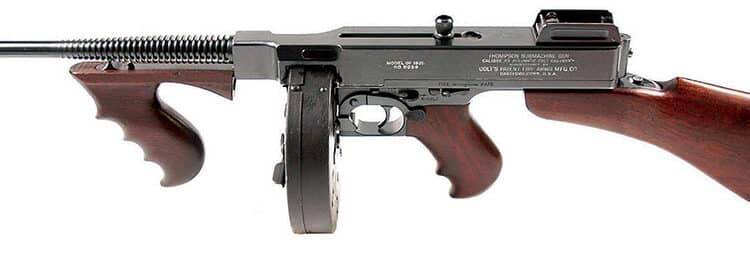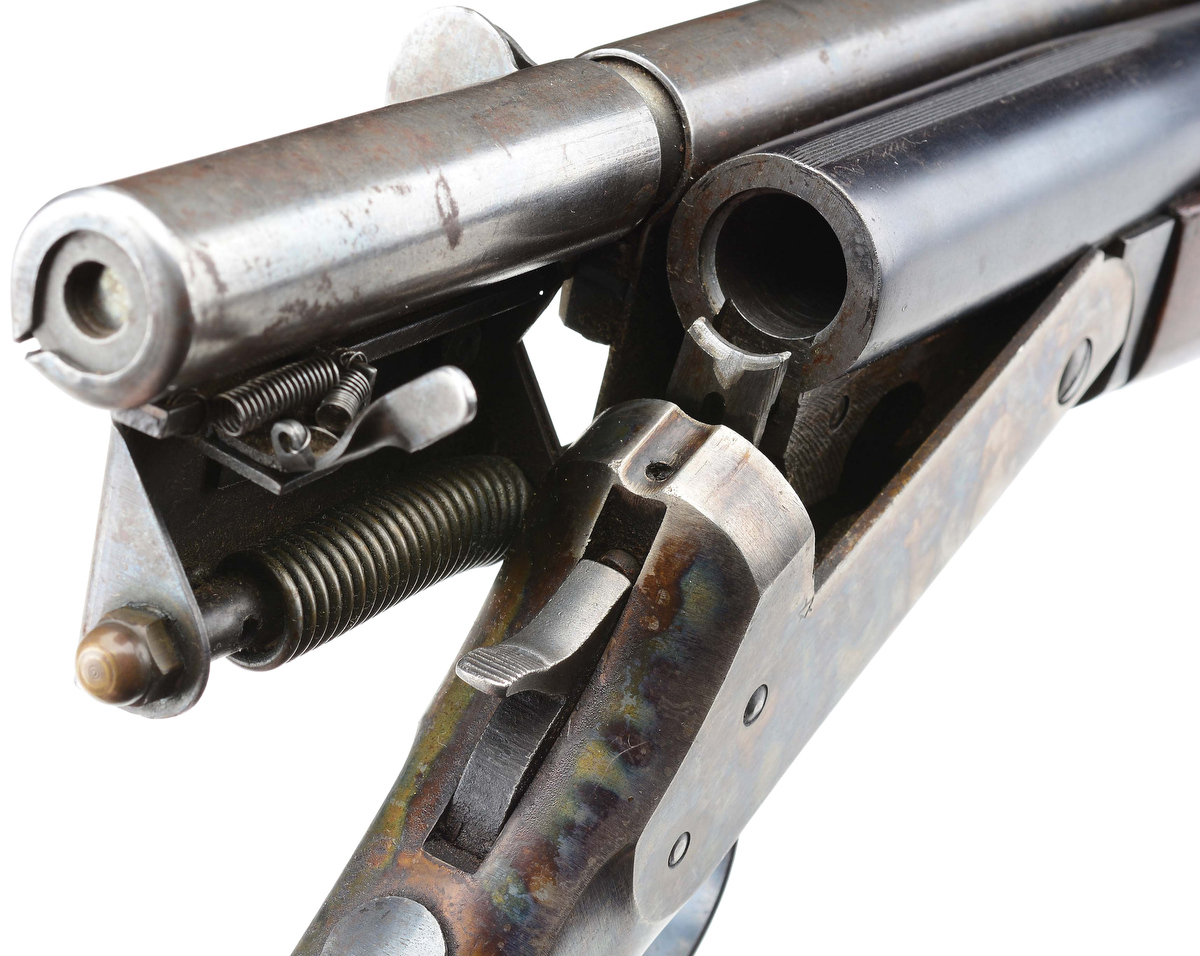By Frank Iannamico
The Thompson submachine gun needs no introduction to most firearm enthusiasts. It was made popular by television shows from the 1960s and was often envisioned around the world as a “gangster’s” gun primarily used by criminals. Although somewhat true, its criminal use has overshadowed the Thompson’s service in World War II by the United States and many of her allies.
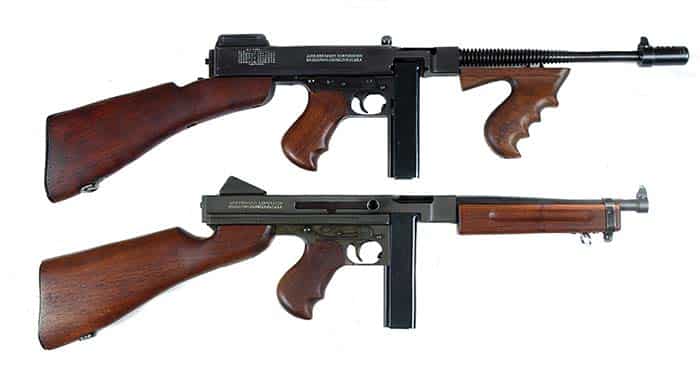
The Thompsons of the Roaring ‘20s
The first Thompsons made infamous by the likes of John Dillinger, Baby Face Nelson and others were manufactured by Colts’ Patent Fire Arms in 1921-1922. Colt was subcontracted by the Auto-Ordnance Corporation that did not have any facilities to manufacture the weapon. Only 15,000 were made. Later, due to slow sales, Auto-Ordnance reinvented the Thompson with the introduction of “new” models. These were nothing other than 1921 Models that were reconfigured to promote sales. Although the Thompson was tested by the U.S. military, few were purchased. In the end, Thompson sales were very slow, and with the bad publicity, the future of Auto-Ordnance Corporation appeared quite bleak. By all appearances, the concept of the Thompson submachine gun was a failure. The Thompson would have to wait for nearly 20 more years for its widespread acceptance by the U.S. military.
In the years following the Thompson’s production, the Auto-Ordnance Corporation was deep in debt. By all accounts, the Thompson submachine gun was a financial disaster.
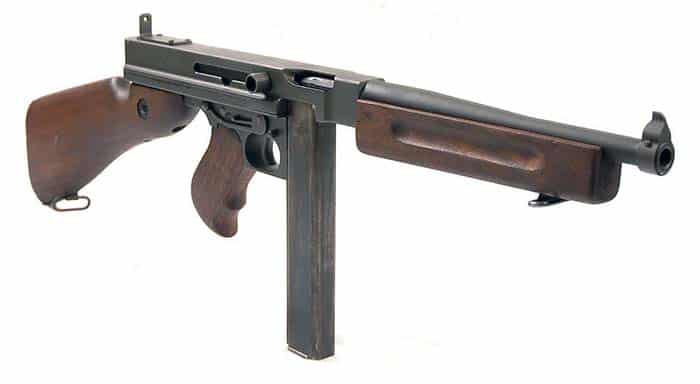
Russell Maguire
During the late 1930s, war clouds were gathering in Europe. Russell Maguire was a shrewd businessman who believed that there soon would be a great worldwide demand for weapons. Maguire decided to purchase the failing Auto-Ordnance Corporation. Through some financial dealings and last-minute ultimatums, Maguire was able to obtain controlling stock in the Corporation.
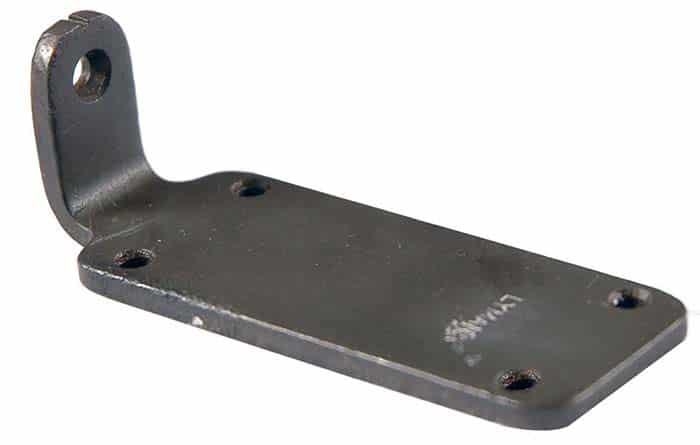
Collect Colt or GI?
The dilemma facing many potential purchasers is which model to choose: the 1920s Colt-era Thompson, a military 1928 series or a military M1-M1A1 (Colt-era Thompson Models 1921A, 1921AC, 1928A, 1928AC, 1928 Navy or 1927).
The Colt-era model started life as a Model of 1921 The AC suffix designates that the muzzle has a Cutts compensator.
All Thompson submachine guns are expensive, but Colt Thompsons are VERY expensive and pretty much fit into the “advanced collector” category. The Colt gun spare parts are also unique, rare and expensive. Thus, owners of Colt Thompsons, as a general rule, don’t shoot them. Those who do, replace as many parts as they can with World War II Thompson parts. However, it isn’t practical to replace the barrel. Bulging a Colt barrel would be catastrophic; replacement barrels are very hard to find.
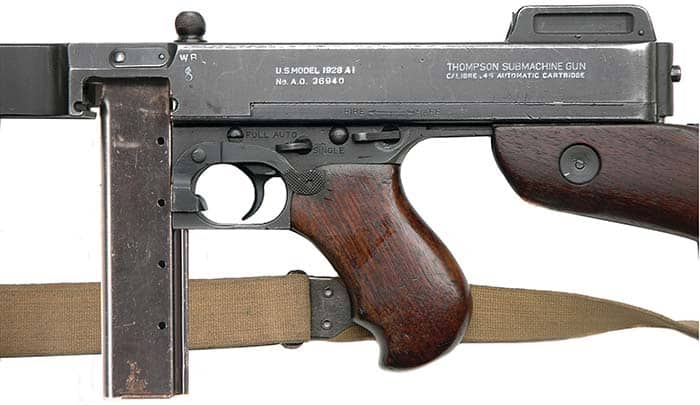
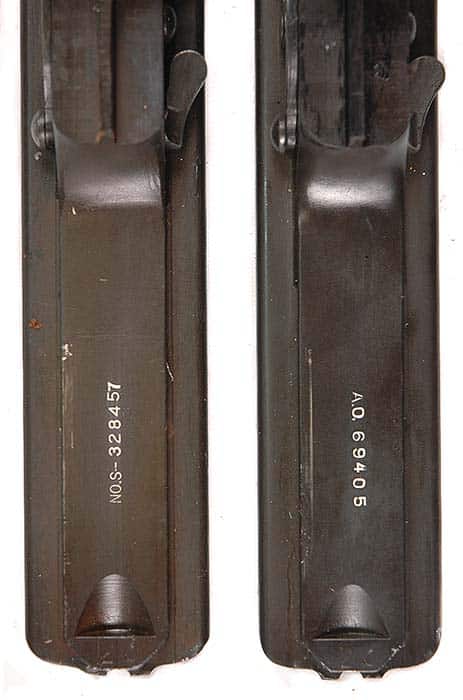
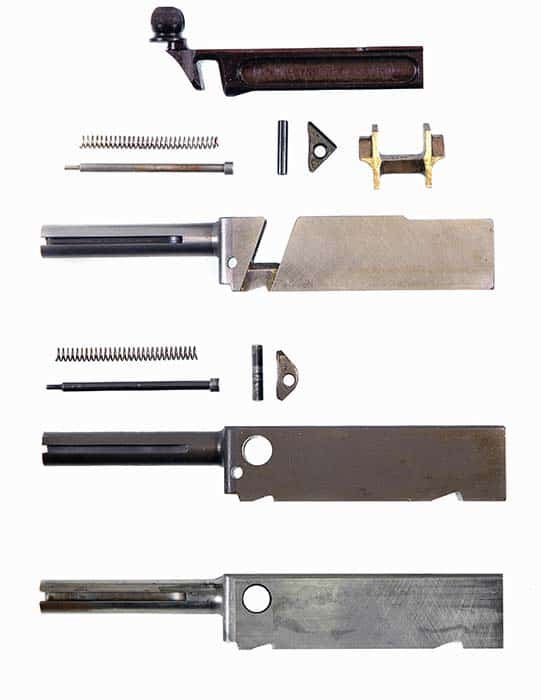
World War II Thompsons
Model of 1928, U.S. Model of 1928A1, Model of 1928AC* and M1-M1A1
During World War II there were approximately 1.5 million Thompson submachine guns manufactured. So, there are a fair number of transferable examples available for collectors. World War II Thompsons were made by Savage Arms, and starting in 1941 Auto-Ordnance opened their own factory. Parts are fairly common, but the supply grows smaller each year, as owners “stock up.”

The 1928 Model
On December 15, 1939, Savage Arms Company signed the first contract to manufacture the Thompson. The 1928 Model Thompsons were the very first Thompsons to come off Savage’s production line, and there were several variations. Many of these guns were sold to the British. A few were sold to Law Enforcement (LE) agencies in the U.S. The LE Thompsons are often referred to by collectors as “Savage Commercials.” The early Thompsons were fitted with finned barrels and Lyman adjustable rear sights and “knurled” cocking (actuator) handles and control levers. Early 1928 Thompsons were fitted with a vertical foregrip. The vertical foregrip of the Thompson submachine gun did not appeal to the U.S. Ordnance Department, and as a result, the vertical style foregrip was replaced by the horizontal grip on most U.S. military contract Thompsons.
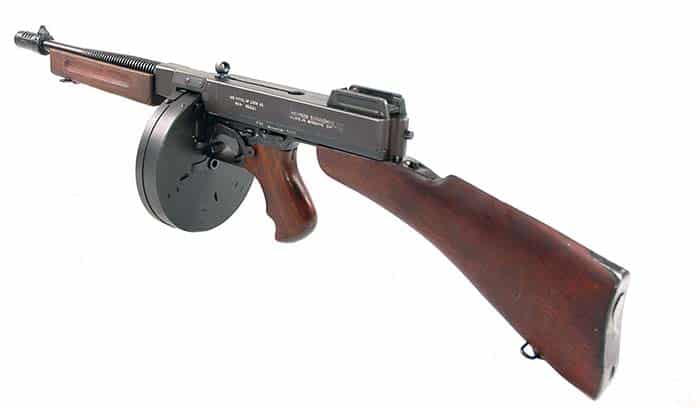
U.S. Model of 1928A1
Thompsons made under contract for the U.S. military had “U.S.” and “A1” added to their receiver markings. These were typical issue U.S. military guns and were given to the Allies after the Lend Lease Act was passed. Early production of the U.S. Model of 1928A1 Thompsons had finned barrels and Lyman adjustable rear sights; later to expedite production and reduce cost, cooling fins were no longer machined onto barrels, and a simple L-type rear sight was fitted. Savage-made Thompsons have a letter “S” prefix serial number, and Auto-Ordnance Bridgeport guns an “AO” prefix serial number.
Model of 1928AC
The 1928AC Thompsons were originally U.S. Model of 1928A1 models but had the “U.S.” marking ground off, and the number “1” in “A1” was overstamped with a letter “C.” Often the serial number had a letter “X” prefix added. Most known examples are Auto-Ordnance Bridgeport production. These were intended primarily for U.S. law enforcement sales.
The receiver serial number of every 1928 and 1928A1 Thompson was also roll marked on the underside of the trigger frame, generally located in the area where the stock was attached. The buttstock must be removed to view the number.
It is quite common to find military issue guns with mismatched trigger frame and receiver serial numbers.
The M1 Thompson Submachine Gun
Late in 1941, the U.S. Ordnance Department had several meetings with Auto-Ordnance officials and engineers to discuss the immediate need to increase production of submachine guns by nearly 100 percent. In November 1941, the engineering staff at Savage began a study of how the M1928A1 model could be simplified. Consuming much of the manufacturing effort was the receiver, more specifically, the rails inside of the receiver that the bronze lock traveled on. The three-piece bolt/lock/actuator of the 1928 model was also labor-intensive to manufacture. The engineers at Savage doubted that the locking device was necessary. In late February of 1942, a prototype of the Savage “simplified” Thompson submachine gun was ready to be submitted to the Ordnance Department for testing. The Savage Corporation told Auto-Ordnance that it was submitting the redesigned Thompson, “ … without any claims for compensation, reimbursement, royalty or patent interest.” The updated Thompson was sent to Aberdeen Proving Ground for testing and evaluation. The Aberdeen trials of the new Thompson were concluded on March 21, 1942. The Aberdeen report stated that “The overall consideration of the mechanical functioning leads to the judgment that the gun as a mechanism is equivalent or superior to the M1928A1.”
One of the major design differences between the M1 Thompson and the M1928A1 model was that the M1 used a straight blowback design and did not use the actuator or controversial bronze “Blish” lock system. The M1 bolt assembly was a simple rectangular block of steel. This allowed the receiver to be redesigned for easier manufacture and its width reduced. The inside of the M1 receiver had a rectangular channel milled into it to accommodate the bolt. The internal felt oiler of the earlier 1928 model was eliminated. The cocking handle and slot were moved from the top of the receiver to the right side. Since drum type magazines had proven unsuitable for military use, the M1 series did not have the drum cutouts and used only stick magazines. Like the 1928 and M1928A1, the early M1 Thompson used a separate firing pin and spring, the same as used in the earlier models. A separate hammer was also used, but the hammers for the M1 were configured differently than that of the 1928 and M1928A1 models.

Both the pilot rod and the buffer were redesigned for the M1 receivers. The pilot rod for the recoil spring was simplified for easier manufacture and was held in place by the new type of buffer. The M1’s pilot rod was made longer than those for the 1928 design to help contain the spring, and along with the new buffer, made disassembly and assembly of the weapon much easier. The M1’s pilot rod and buffer lessened the possibility of damaging the recoil spring during assembly and disassembly; a problem often encountered with the earlier 1928 design. The pilot rod could be removed and installed through the rear of the receiver after the buffer was removed.
The M1 featured a barrel without the radial cooling fins, similar to the one fitted to the late M1928A1 models, but the muzzle end was not threaded for a compensator. A simple blade sight was fitted and pinned to the muzzle. The configuration of the rear portion of the M1’s trigger frame was redesigned slightly to fit the beveled contour of the redesigned receiver. The frame design did not include provisions for the removable buttstock of the M1928A1 version. Early M1s were manufactured using the same paddle-type rocker pivot and safety levers, without the knurled surfaces. These were eventually replaced with the simpler two-piece pin type.
One of the immediately noticeable features of both the M1 and M1A1 guns is their bolt. The bolt was redesigned with two sear notches. This allowed the weapon’s safety lever to be engaged when the bolt was in the forward position on an empty chamber.

The rear sight installed on early production M1 Thompsons was the same simple unprotected “L” type, also fitted on late production M1928A1s. This design proved to be easily damaged and was replaced by a similar sight but with protective side “ears.” The new sight first appeared on the Savage Arms M1 Thompsons in the high 137000 serial number range.
The pistol grip and stock were reconfigured and designed to fit the M1 trigger frame. The contour of the stock differed from the earlier 1928 and M1928A1 designs. The stock’s buttplate was also simplified but retained a trap door for storage of a large cylindrical oil bottle. By July 1942, Savage began delivery of the first of the new Thompson models, designated as the Caliber .45, M1 Submachine Gun.
The M1A1 Model
In September 1942, Aberdeen Proving Ground was instructed to test “A modified version of the M1 submachine gun that eliminated the firing pin, firing pin spring, the hammer and hammer pin.” The four parts were eliminated from the design by making the firing pin an integral part of the bolt. Tests at Aberdeen indicated that the M1 submachine gun equipped with a fixed firing pin functioned slightly better than the standard M1 submachine gun. It was also noted that the fixed pin design saved considerable manufacturing time and that the bolt was strengthened by the elimination of the deep drilling operation necessary to accommodate the firing pin and spring. The Springfield Ordnance District was notified that manufacture of a fixed firing pin bolt for use in the M1 submachine gun was authorized. In order to distinguish between submachine guns equipped with separate firing pins and fixed firing pins, the submachine guns fitted with the fixed firing pin would be designated as Gun, Submachine, Caliber .45, Thompson M1A1 (A1= Alteration 1).
The design of the M1A1, along with the redesign of many other parts for faster production, had reduced the time required to manufacture an M1A1 by 10.11 hours over the earlier M1928A1 model.
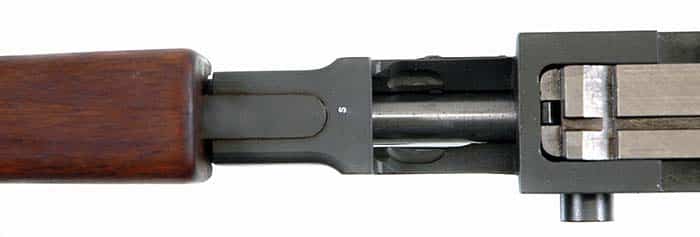
Miscellaneous small parts common to all World War II Thompson models include: the trigger, sear, sear lever, trip, disconnector, pivot plate, frame latch pin and spring, rocker, rocker pivot, safety lever, sling swivels, foregrip, grip mount, foregrip and pistol grip screws, 1928-type magazine catch and extractor. The hammer pin, firing pin and spring were common to the 1928, 1928A1 and M1 models.
The M1 and M1A1 weapons that the Savage and Auto-Ordnance factories produced are identical in appearance and specification, and all parts were completely interchangeable. Unlike the 1928 Thompsons, the manufacturer’s initials, AO or S, were not used as a serial number prefix on the M1 series. To identify who made a particular M1 or M1A1 Thompson, the manufacturer stamped its code letters on the bottom of the receiver where the front grip mount is fitted. The letters used were “S,” which indicated Savage manufacture, or “A.O.C.” for weapons made at the Auto-Ordnance Bridgeport plant. Savage-made Thompsons are more common than those made at the Auto-Ordnance factory. However, regardless of the manufacturer, the receivers are all marked “Auto-Ordnance Bridgeport, Connecticut.”
In January 1943, the Ordnance Department announced to the Auto-Ordnance Corporation that the Thompson was going to be replaced by the new U.S. M3 submachine gun. There were several manufacturing problems encountered with the M3 that had required Thompson production to be extended for several months until production difficulties could be solved. On February 15, 1944, the very last M1A1 Thompson submachine gun was accepted by the government.
The Savage Arms Corporation manufactured an estimated total of 464,800 M1 and M1A1 model Thompsons, while the Auto-Ordnance Bridgeport plant turned out an estimated 249,555 M1 and M1A1s. The protected rear sight began to appear on Savage M1 models at the high 137000 serial number range.
Pros and Cons
The 1928 Models
The 1928A1 military model seems to be more popular among collectors because of its recognizable “Thompson” appearance. There are also more transferable 1928 Thompsons than the M1-M1A1 in the registry. A substantial number of U.S. 1928A1 spare part kits, less receivers, in new condition were imported a few years ago, making spare parts available. The top-mounted cocking handle makes the weapon suitable for left- or right-handers. Drum or box magazines can be used. If a more compact weapon is desired, the buttstock is easily removed by pushing a button and sliding it off the receiver. This model is more common than the M1-M1A models and easily controlled in full-auto fire due to its weight.
The M1 and M1A1
The M1 Thompsons are less complicated and easier to field strip. The receiver is narrower and the weapon is lighter than a 1928. The overall length is shorter without a compensator, which is difficult to clean. Simple rear sights are designed for faster target acquisition—easier to use than the Lyman adjustable sight. The M1 and M1A1 were in military service longer than the 1928 series, serving in World War II, Korea and Vietnam. The M1 model may appeal more to a collector of militaria. M1 and M1A1 models are less common than their 1928 counterparts. Parts for the M1 and M1A1 are not as common as those for the 1928, but many internal parts are the same. Collectors cannot use a drum magazine; magazines are limited to 20- and 30-round box magazines. The stock is attached to the frame with screws and cannot be easily removed as the 1928 model. The safety can be applied with the bolt closed. The M1 is easily controlled in full-auto fire due to its weight.
Recommended reading: American Thunder III, the Military, the Thompson Submachine Guns, available from Chipotle Publishing, LLC. www.smallarmsreview.com
| This article first appeared in Small Arms Review V22N3 (March 2018) |



